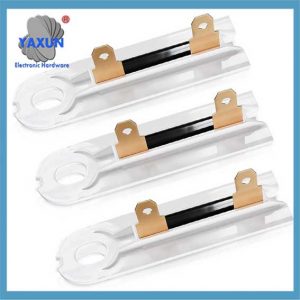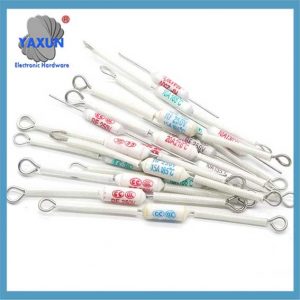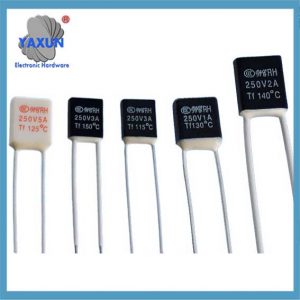Product Categories
Product Tags
Models and Applications of Thermal Cut-Out link Fuse
A thermal fuse is also known as a tmperature fuse, thermal link, thermal cut-out (TCO), or one shot. It is a temperature sensing circuit cut-off device (China custom metal, ceramic, square shell thermal fuse). A limitor thermal fuse can sense the overheating generated by abnormal operation of electrical and electronic products, thereby cutting off the circuit to avoid fire.
What is a thermal fuse?
A thermal fuse is also known as a tmperature fuse, thermal link, thermal cut-out (TCO), or one shot. It is a temperature sensing circuit cut-off device (China custom metal, ceramic, square shell thermal fuse). A limitor thermal fuse can sense the overheating generated by abnormal operation of electrical and electronic products, thereby cutting off the circuit to avoid fire.
A limitor thermal cut-out fuse functions as a safety device that automatically interrupts an electrical circuit when the temperature reaches a predetermined threshold, essentially acting as a “heat-activated circuit breaker” to prevent overheating and potential fire hazards in appliances or equipment by cutting off power when excessive heat is detected; it’s primarily used in devices like hairdryers, Dryer, coffee makers, and electric motors where overheating could occur due to malfunctioning components.
Key points about thermal fuses:
How it works:
When the temperature around the thermal fuse exceeds its rated temperature, a special fusible material inside melts or breaks, causing the circuit to open and stopping the flow of electricity.
Non-resettable:
Unlike regular fuses, a thermal fuse cannot be reset once it has tripped and needs to be replaced if overheating occurs.
Its structure and working principle:
It consists of a sliding contact , a spring, and a electrically nonconductive thermalpellet. Before the thermal fuse is activated, the current flows from the left lead to the movable contact (sliding contact), and flows to the right lead through the metal shell. When the external temperature reaches the predetermined temperature, the fusible element melts and the compression spring becomes loose. That is, the spring expands, and the sliding contact separates from the left lead. The circuit is opened, and the current between the sliding contact and the left lead is cut off.
Temperature-sensitive only:
Unlike a standard circuit breaker, a thermal fuse only responds to temperature changes, not current surges.
Applications:
Household appliances: Hairdryers, toasters, electric blankets, Transformers, Electric motors, Electric fans, Hair dryers, Electric irons, Rice cookers, Copiers, Electric stoves, Chargers, power taps, Water dispensers, Coffee makers etc.
Motor applications: Electric motors in appliances and machinery
Industrial equipment: Transformers, heating elements, power tools.
Product Description
| Item | thermal fuse, thermal cutoff, thermal link |
| Body Tyle | Metal |
| Lead Dia | 1mm |
| Lead Length | see table 3 |
| Current Rating | 15A 10A 20A @250VAC |
| Mounting Type | axial leaded |
| Body Dia | 4mm |
| Body Length | 14.7mm |
| Certifications | UL VDE |
Thermal fuse models and cut-off temperature table:
| Tf ºC | G4A | G5A | ||
| Th ºC | Tm ºC | Th ºC | Tm ºC | |
| 72 | 57 | 100 | 57 | 410 |
| 73 | 58 | 100 | 58 | 410 |
| 77 | 62 | 300 | 62 | 410 |
| 84 | 69 | 220 | 69 | 220 |
| 91 | 76 | 300 | 76 | 430 |
| 93 | 78 | 300 | 78 | 410 |
| 98 | 83 | 300 | 83 | 410 |
| 104 | 89 | 200 | 89 | 225 |
| 110 | 95 | 240 | 95 | 225 |
| 117 | 102 | 240 | 102 | 410 |
| 121 | 106 | 300 | 106 | 410 |
| 125 | 110 | 185 | 110 | 235 |
| 128 | 113 | 205 | 113 | 235 |
| 134 | 119 | 205 | 119 | 410 |
| 141 | 126 | 205 | 126 | 350 |
| 144 | 129 | 300 | 129 | 410 |
| 152 | 137 | 205 | 137 | 410 |
| 158 | 143 | 240 | 143 | 410 |
| 167 | 152 | 210 | 152 | 410 |
| 172 | 157 | 310 | 157 | 410 |
| 184 | 169 | 240 | 169 | 410 |
| 190 | 175 | 350 | 175 | 410 |
| 192 | 177 | 210 | 177 | 350 |
| 205 | 190 | 310 | 190 | 410 |
| 216 | 200 | 450 | 200 | 410 |
| 229 | 200 | 450 | 200 | 410 |
| 240 | 200 | 450 | 200 | 410 |
| 257 | 220 | 470 | – | – |
Contact Us
Waiting for your email, we will reply you within 12 hours with valuable information you needed.
 English
English العربية
العربية Български
Български 粤语
粤语 中文(简体)
中文(简体) 中文(漢字)
中文(漢字) Nederlands
Nederlands Suomi
Suomi Français
Français Deutsch
Deutsch Ελληνικά
Ελληνικά Magyar
Magyar Italiano
Italiano 日本語
日本語 한국어
한국어 Polski
Polski Português
Português Română
Română Русский
Русский Slovenščina
Slovenščina Español
Español Svenska
Svenska ภาษาไทย
ภาษาไทย Türkçe
Türkçe Tiếng Việt
Tiếng Việt












